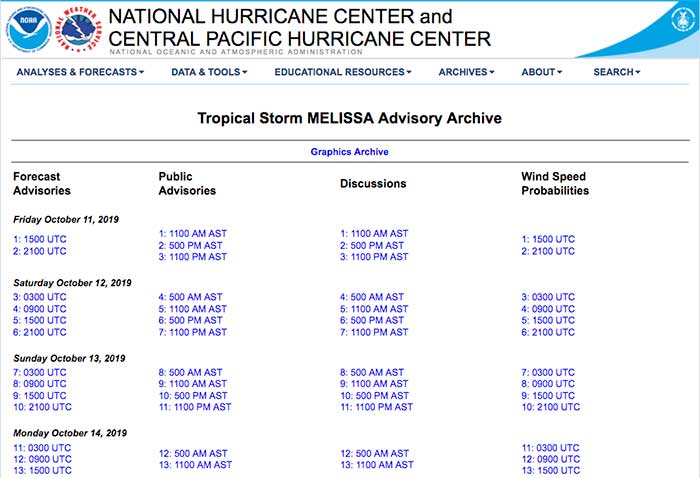Advertisement
Understanding Coordinated Universal Time, or Zulu time.

Advisory from NOAA
Imagine this: The National Weather Service just issued a Public Advisory regarding a tropical storm forming in the Atlantic Ocean. Several models are predicting that the storm is heading straight toward the area where you keep your boat in about five days. Now you need to prepare your boat for the storm. When was that advisory issued? You scan and see 1500 UTC stamped on the weather map. You know 1500 is the 24-hour time (or military time) notation for 3 p.m. But what time zone is that in? For that, you'll need to convert UTC time to your local time.
What Is UTC?
UTC, short for Coordinated Universal Time, and sometimes referred to as "Zulu time" or "Z-time," is not a time zone but a time standard. It's used by world timing centers to keep time scales synchronized across the globe. Anything connected to GPS satellites is automatically updated to the correct local time. UTC is based on 24-hour military time and doesn't recognize local adjustments like Daylight Saving Time, so it's a very accurate and consistent way to discuss time no matter where you are in the world.
History Of UTC
Until 1884, there was no agreed time standard worldwide. Local communities kept their own time, which was confusing, especially for weather forecasting and train travel. At the 1884 International Meridian Conference in Washington, D.C., 25 countries got together and agreed on the prime meridian, or 0° longitude. The prime meridian passes through Greenwich, England, and divides the Eastern and Western hemispheres. In fact, it runs directly through the Royal Observatory's telescope. Initially this was known as Greenwich Mean Time (GMT).
The UTC standard was formalized by the International Radio Consultive Committee in 1960 and officially put into practice a year later. The name Coordinated Universal Time was adopted in 1967.
How UTC Works
The Earth is broken into 24 time zones. UTC is based on when noon occurs in the Greenwich Mean Time (GMT) time zone. Each time zone to the west of the prime meridian is a negative expression, and each time zone to the right is a positive. Because there is 360 degrees around the Earth each 15-degree change in longitude is equal to one hour. So, 12 p.m. in Greenwich is expressed as 00:00 UTC. The time zone to the west is -1 and the time zone to the east is +1. The International Date Line, which is 180 degrees from the prime meridian, is the dividing line between calendar days.
Using the chart below, you can easily convert local time to UTC for much of the Western hemisphere. Find your local time in the left column and your time zone across the top row. Where the two intersect is the current UTC time.
| Local | EDT | EST | CDT | CST | MDT | MST | PDT | PST |
| Midnight | 0400 | 0500 | 0500 | 0600 | 0600 | 0700 | 0700 | 0800 |
| 1 a.m. | 0500 | 0600 | 0600 | 0700 | 0700 | 0800 | 0800 | 0900 |
| 2 a.m. | 0600 | 0700 | 0700 | 0800 | 0800 | 0900 | 0900 | 1000 |
| 3 a.m. | 0700 | 0800 | 0800 | 0900 | 0900 | 1000 | 1000 | 1100 |
| 4 a.m. | 0800 | 0900 | 0900 | 1000 | 1000 | 1100 | 1100 | 1200 |
| 5 a.m. | 0900 | 1000 | 1000 | 1100 | 1100 | 1200 | 1200 | 1300 |
| 6 a.m. | 1000 | 1100 | 1100 | 1200 | 1200 | 1300 | 1300 | 1400 |
| 7 a.m. | 1100 | 1200 | 1200 | 1300 | 1300 | 1400 | 1400 | 1500 |
| 8 a.m. | 1200 | 1300 | 1300 | 1400 | 1400 | 1500 | 1500 | 1600 |
| 9 a.m. | 1300 | 1400 | 1400 | 1500 | 1500 | 1600 | 1600 | 1700 |
| 10 a.m. | 1400 | 1500 | 1500 | 1600 | 1600 | 1700 | 1700 | 1800 |
| 11 a.m. | 1500 | 1600 | 1600 | 1700 | 1700 | 1800 | 1800 | 1900 |
| NOON | 1600 | 1700 | 1700 | 1800 | 1800 | 1900 | 1900 | 2000 |
| 1 p.m. | 1700 | 1800 | 1800 | 1900 | 1900 | 2000 | 2000 | 2100 |
| 2 p.m. | 1800 | 1900 | 1900 | 2000 | 2000 | 2100 | 2100 | 2200 |
| 3 p.m. | 1900 | 2000 | 2000 | 2100 | 2100 | 2200 | 2200 | 2300 |
| 4 p.m. | 2000 | 2100 | 2100 | 2200 | 2200 | 2300 | 2300 | 2400 |
| 5 p.m. | 2100 | 2200 | 2200 | 2300 | 2300 | 2400 | 2400 | 0100 |
| 6 p.m. | 2200 | 2300 | 2300 | 2400 | 2400 | 0100 | 0100 | 0200 |
| 7 p.m. | 2300 | 2400 | 2400 | 0100 | 0100 | 0200 | 0200 | 0300 |
| 8 p.m. | 2400 | 0100 | 0100 | 0200 | 0200 | 0300 | 0300 | 0400 |
| 9 p.m. | 0100 | 0200 | 0200 | 0300 | 0300 | 0400 | 0400 | 0500 |
| 10 p.m. | 0200 | 0300 | 0300 | 0400 | 0400 | 0500 | 0500 | 0600 |
| 11 p.m. | 0300 | 0400 | 0400 | 0500 | 0500 | 0600 | 0600 | 0700 |
